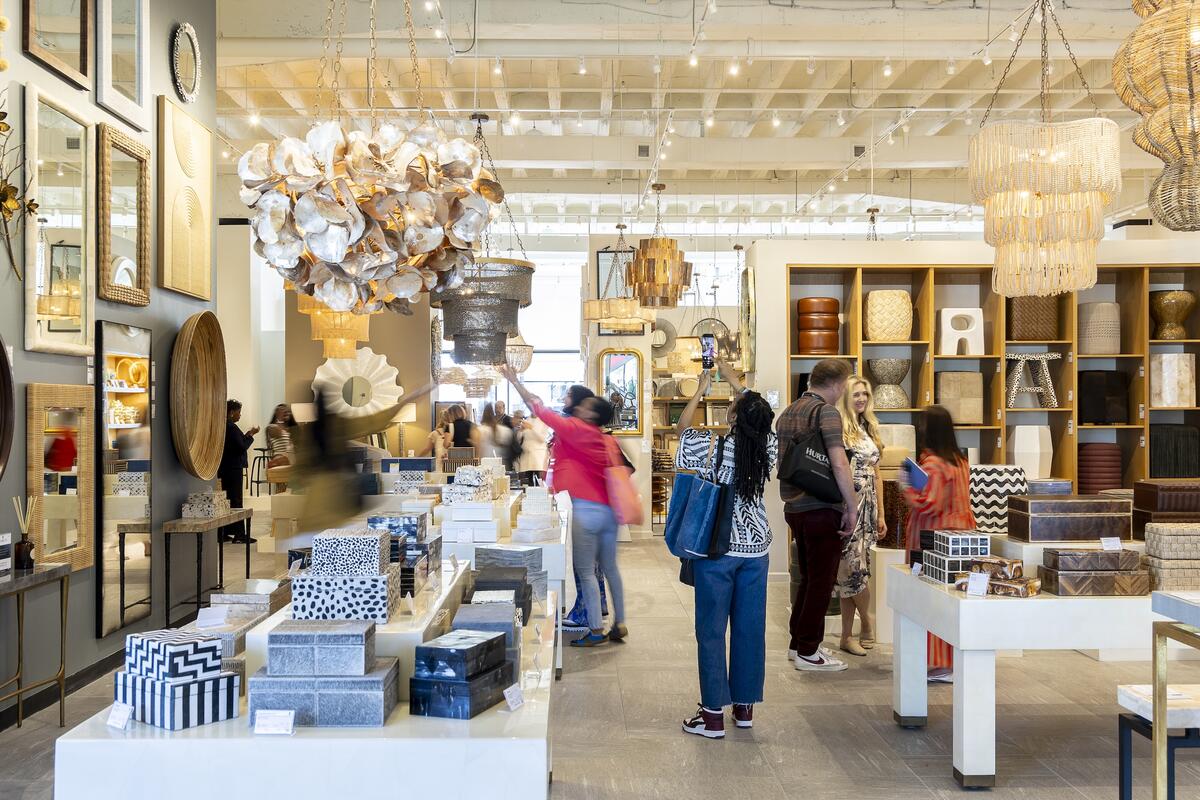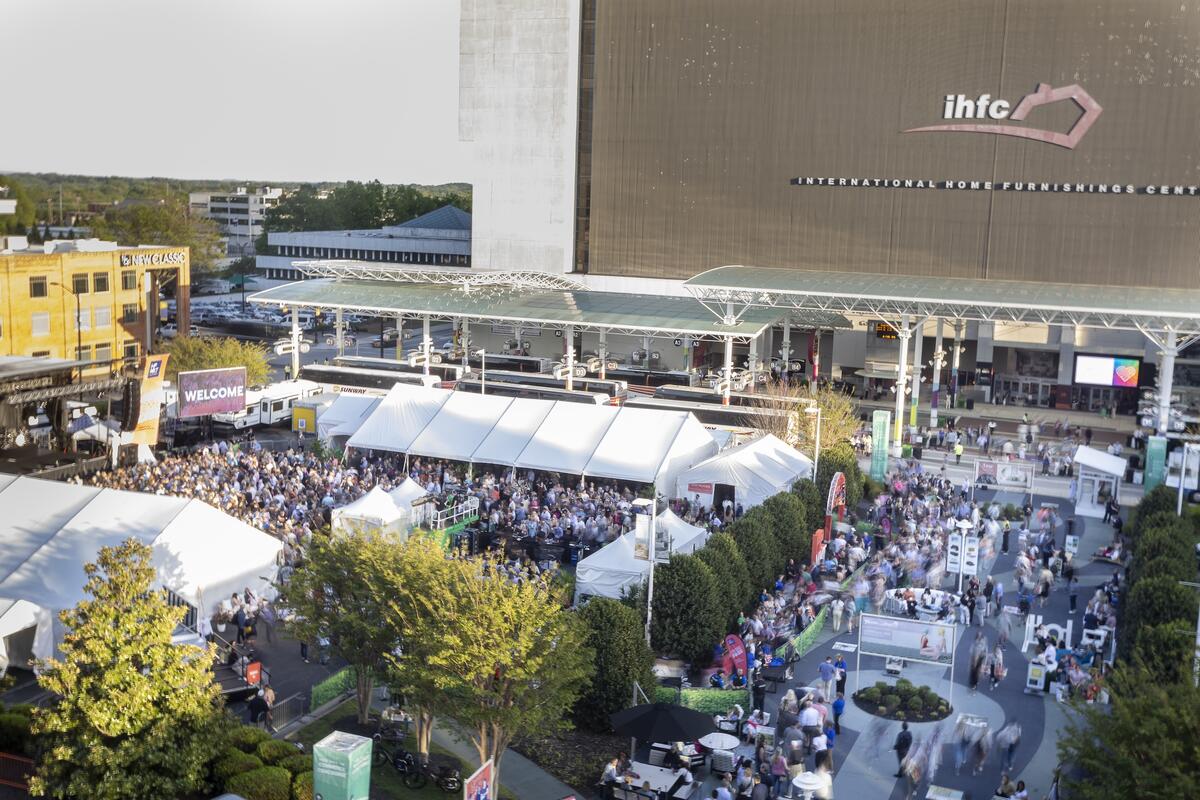That’s a wrap! Another High Point Market is in the books. Though the broader industry is still looking to shake off the post-boom doldrums, there was plenty to get excited about across a (mostly) sunny long weekend in North Carolina, and Business of Home’s editorial team was on the ground to take it all in. Here, we look back on what mattered at Market.
TRAFFIC CONDITIONS
A scheduling conflict with Salone del Mobile pushed some longtime attendees to either skip Market or leave early for Milan, but new attendees more than made up for the slack, with first-time registrants surging 13.8 percent over Fall Market’s numbers.
Official attendance numbers show a steady turnout—up 1 percent over last spring and down 2 percent from last fall. However, despite healthy overall numbers, individual showroom traffic was a moving target, and no one could agree on whether things were busy or slow, even exhibitors in the same building. A possible culprit: Despite the event’s official start of Saturday, Marketgoers seem to be arriving earlier and earlier every year. Buyers for major retailers like Wayfair were reportedly in and out by Wednesday, which is also when designers started scooping up one-of-a-kinds and antiques all over town. Those early arrivals may be shifting traffic patterns and leading to the strange sense that foot traffic was down—even if it’s just more spread out.
INDUSTRY TRENDS
The good news: For most exhibitors, inventory is finally under control, and most CEOs suggested that order writing at Market, while certainly not record setting, seemed to be healthy. For retailers, the picture is far more mixed. While the high end is generally in a good place, some lower-end stores are still holding too much, stunting sales for manufacturers. And though the supply chain isn’t on the tip of anyone’s tongue these days, it’s still complicated. Many manufacturers are sourcing from a wider variety of global destinations than ever before, and they face complex decisions in order to fill their containers.
At the high end, exhibitors also reported that their designer clients seem more rushed than ever before, citing in-stock product and short lead times as key factors driving their orders. Often, that manifested in the widespread expansion of configurable programs for categories like upholstery and case goods, which offer efficient ways to deliver customization quickly. And while most brands wait for buyer interest at Market to fully commit to the pieces they’ll add to their line, Century came to High Point already sitting on the inventory for the case goods on the floor—slashing wait times from six months for cutting and importing to just the finishing time for the piece, and ensuring there’s no chance that a product you loved won’t make it into the line—all in an effort to build customer confidence and capitalize on immediate demand. While that level of investment is a surprising example for now, that may not be the case for long.

CAUTIOUS LAUNCHES
Many brands opted to introduce line extensions and riffs on their bestsellers instead of debuting completely new products—suggesting that they were looking for a surefire win rather than a risky bet in this volatile economic climate. The upside was a crowd-pleaser of a show: When brands find clever ways to tweak their winners—the chair that becomes a chaise, the bedside table that turns into a credenza—the result is a medley of great, usable new pieces. The downside was fewer boundary-pushing designs. The best answer to the perennial Market question “What have you been seeing?” was sometimes quite simply, “More of the same.”
TALK OF THE TOWN
Not everyone played it safe—and a few brands truly swung for the fences with bold, groundbreaking introductions. We’ve been following Abner Henry’s ascent for several years, but its gutsy collaboration with Sasha Bikoff this spring meant the the Ohio-based Amish furniture company was on everyone’s lips. For many Marketgoers, this was also their first chance to check out the brand’s collaboration with the Metropolitan Museum of Art, which debuted last fall. Stay tuned: We got some off-the-record scoop that suggests even more great partnerships to come.
Another crowd-pleaser was designer Amber Lewis’s expansive collection for Four Hands, which clocked in at more than 220 SKUs. The collaboration seems to be a winning one, reportedly breaking sales records before Market even closed. It’s also prolific: We heard there’s more in the pipeline that will be added to the line this fall.
British lighting brand Pooky unveiled one of the most inventive InterHall booths in recent memory, turning its space into a carnival-esque venue, complete with a whimsical carousel that showcased the company’s lighting and lampshade selection.
PEOPLE AND PARTIES
HPMA’s keynote series in the High Point Theatre featured a star-studded lineup, starting with a reprise of last fall’s conversation with panelists Joanna Gaines, Amber Lewis, Leanne Ford and Brigette Romanek, moderated by The Business of Home Podcast host Dennis Scully. (A crowd lined up more than two hours before it started in order to nab a seat.) Other keynotes included talks by Bunny Williams, who had the audience hanging on her every word as she shared her approach to designing both interior spaces and gardens, and Martyn Lawrence Bullard, who lingered for nearly two hours with attendees eager to meet him. In these programs, and the panels that unfolded at showrooms all over Market, one thing was abundantly clear: Networking has become an essential driver of designer attendance and enthusiasm.
That same star power enlivened after-hours programming as well, as a surprising number of major artists converged on Sunday. HPMA hosted the Goo Goo Dolls for a jam-packed concert at Center Stage that night, while Loloi celebrated its 20th anniversary with a private party that featured an intimate 45-minute set from Grammy winner Leon Bridges.

BRANDS IN TRANSITION
Whether sparked by new leadership or new locations, several companies brought a fresh energy to their showroom presentations. It was an especially great showing for Caracole, which debuted a streamlined assortment and recalibrated look designed to take the international market by storm—the influence of Alessandro Fabrini, who joined as company president last June. (Up next for this brand: Salone.) Meanwhile, as it settles into its new showroom on South Hamilton, Hickory Chair showed a refreshing confidence in its displays—proof that new president Federico Contigiani is beginning to make his mark.
Other brands to watch include Fairfield, which debuted new branding and an updated showroom layout this season—the first step in what seems to be a coming reinvention—and Burton James, which was recently acquired by Made Goods and is well-positioned for transformation. We should also expect big things from Surya in the Markets to come. The brand has made some major moves with the acquisition of Global Views and Mitchell Gold + Bob Williams and will be re-imagining the way it organizes its assortment as it becomes a major player in the whole-home space.
Last but not least is Bassett Furniture, which opened a sprightly booth in InterHall designed to present its range in a new, more trend-forward light in addition to its main showroom on the 12th floor. It looked a lot like the brand was taking a page out of Hooker’s playbook—the company used a similar strategy a few years ago, displaying a youthful brand expression in InterHall to drive attendees upstairs into its primary showroom for several Markets before opening its expansive new flagship in Showplace with a new look and a refreshed assortment. If that’s true, there may be much more to come.




























